The Relative Strength Index (RSI) define overbought and oversold conditions. Rocky White researches have it has forecasted moves in the S&P 500.
The S&P 500 Index (SPX) had its worst day of the year on Monday. This sent the Relative Strength Index (RSI) crashing, indicating an oversold market. The RSI is a popular technical indicator that oscillates between zero and 100. A level above 70 is often considered overbought, while a level below 30 is considered oversold.
Based on this simple interpretation, the RSI reading below 30 should be a good sign that stocks are now due for a bounce. The problem with simple interpretations of popular indicators is that their actual implications — based on actual numbers — doesn’t often match with the prevailing view. In the analysis below, I’ll show you the actual numbers of how stocks have performed after previous oversold readings. Also, I’ll see if a collapse of the indicator, rather than a slower march lower, has had different consequences.
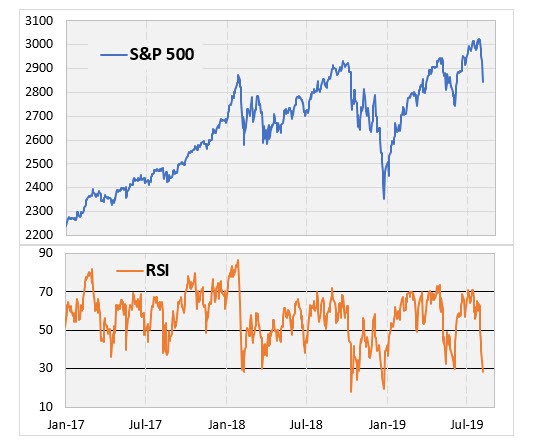
GENERAL RSI NUMBERS
Here’s a simple measure of how the S&P 500 has performed over the next month based on the RSI reading. I went back to 1950 and found the one-month return of the index based on whether the RSI was below 30, above 70, or somewhere in between. The index has in fact had the highest average return when the RSI reading was below 30. In that case, the S&P 500 has averaged a 1.17% return over the next month. Otherwise, the average return has been 0.69% when the indicator is between extremes, and 0.79% when it has been above 70. The problem with the below 30 reading is a higher than usual standard deviation and a percent positive that is less than average. So, the returns have been good, but volatility has increased.
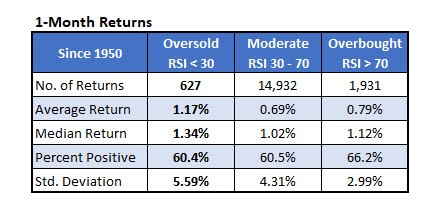
When looking at the returns since 2010, which gets us past the financial crisis, the indicator has performed terrific. When the RSI reading has been below 30, the S&P 500 has returned an average of 3.74% over the next month, with almost 80% of the returns positive. When the indicator has flashed an overbought signal, the index has gained just 0.33% with 62% of the returns positive.
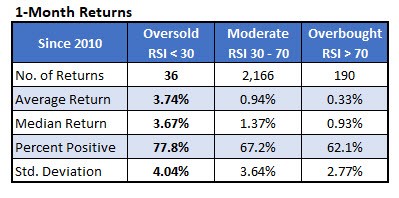
RSI CROSSES BELOW 30
One thing about the analysis above is that it is guaranteed to capture the rebound when the RSI moves higher. The RSI can move into oversold territory and stay there for some time during which the market struggles, sending the RSI even lower. When stocks rebound, they tend to do so quickly. The RSI then turns higher and takes some time to move above 30. The returns in the analysis above are capturing all that and then the next month going forward. So, here’s another way of looking at it.
The table below looks at how the S&P 500 has performed after the RSI falls below 30 for the first time in a month. It only looks at returns after that initial close below 30. In this case, you can see the returns are not nearly as bullish. In fact, the index has tended to struggle in the short-term. The average return has been negative over the next two weeks, with only half of the returns positive. Over the next month, the time frame that showed to be bullish in the analysis above, in this case has underperformed typical market returns. The longer-term returns — three and six months — are broadly in line with typical market returns.
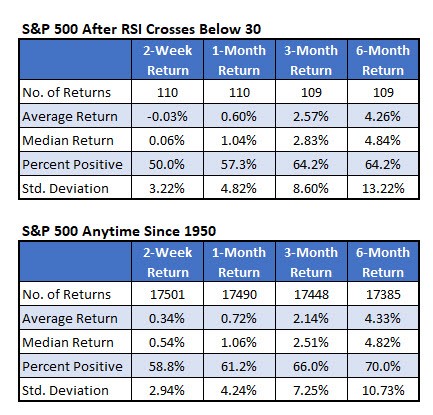
Looking at the recent results of these crosses below 30, however, is encouraging. Since 2010, the returns after these initial drops below 30 are bullish across all time frames. There’s no short-term bearishness and the average returns beat normal market returns at each time frame.
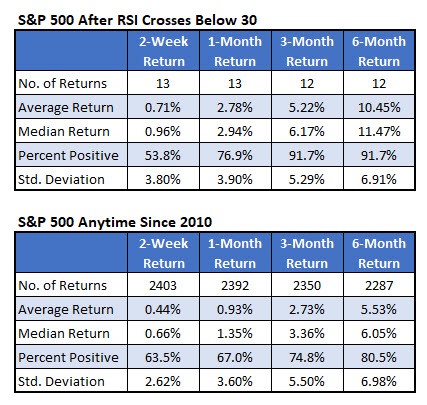
Finally, here’s another way to look at it. I noted above how the RSI didn’t just march down to the 30 level. It was at a rather high level, a short time ago and then it suddenly caved below the oversold level. In a week, the RSI went from about 60 all the way below 30. Since 1950, there were only 12 other occasions when the RSI was below 30 after being above 50 at some point over the last week.
The table below summarizes the returns after these occurrences. There’s still short-term weakness, with the S&P 500 averaging a loss over the next two weeks with only about 40% of the returns positive. After that, however, the index has performed very well. Three months after these signals, the S&P 500 has gained an average of 3.82% with 83% of the returns positive.
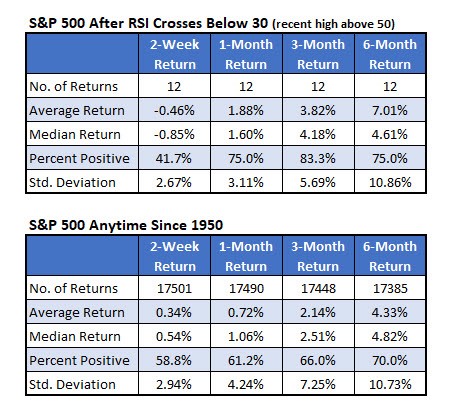
Everything considered, the analysis above seems to indicate a good chance at bullish returns in the medium-term with potential bearishness in the short-term.
Our research into the RSI indicates something you may already know, something most technicians understand. The RSI is a very useful tool but is not a great stand-alone indicator. Most technicians view the RSI as a confirming indicator. If you believe a market is due a reversal based on other technical factors buoyed perhaps by volume figures and the RSI confirms that point-of-view, that signal is stronger.
Sign up here for the Schaeffer’s Research Edge weekly newsletter










